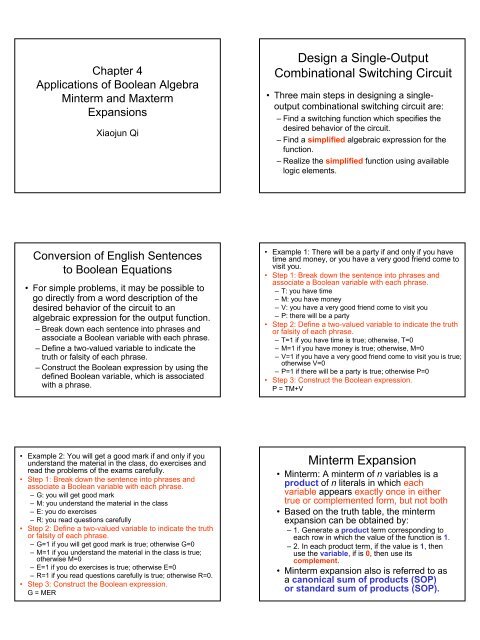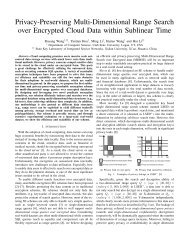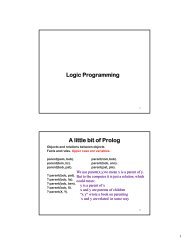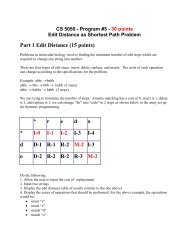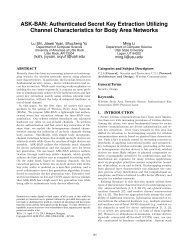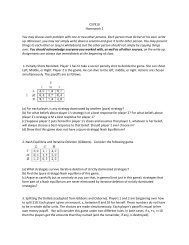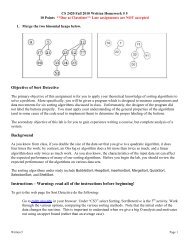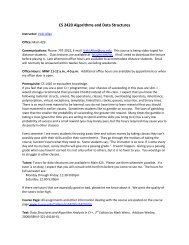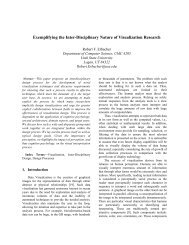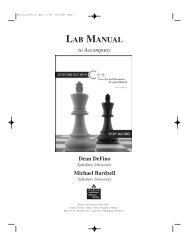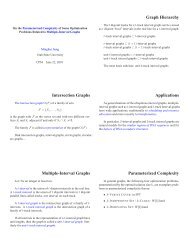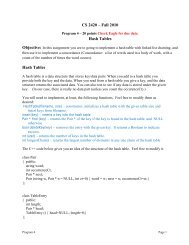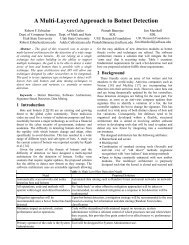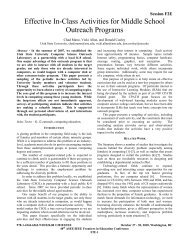Design a Single-Output Combinational Switching Circuit Minterm ...
Design a Single-Output Combinational Switching Circuit Minterm ...
Design a Single-Output Combinational Switching Circuit Minterm ...
Create successful ePaper yourself
Turn your PDF publications into a flip-book with our unique Google optimized e-Paper software.
Chapter 4<br />
Applications of Boolean Algebra<br />
<strong>Minterm</strong> and Maxterm<br />
Expansions<br />
Xiaojun Qi<br />
Conversion of English Sentences<br />
to Boolean Equations<br />
• For simple problems, it may be possible to<br />
go directly from a word description of the<br />
desired behavior of the circuit to an<br />
algebraic expression for the output function.<br />
– Break down each sentence into phrases and<br />
associate a Boolean variable with each phrase.<br />
– Define a two-valued variable to indicate the<br />
truth or falsity of each phrase.<br />
– Construct the Boolean expression by using the<br />
defined Boolean variable, which is associated<br />
with a phrase.<br />
• Example 2: You will get a good mark if and only if you<br />
understand the material in the class, do exercises and<br />
read the problems of the exams carefully.<br />
• Step 1: Break down the sentence into phrases and<br />
associate a Boolean variable with each phrase.<br />
– G: you will get good mark<br />
– M: you understand the material in the class<br />
– E: you do exercises<br />
– R: you read questions carefully<br />
• Step 2: Define a two-valued variable to indicate the truth<br />
or falsity of each phrase.<br />
– G=1 if you will get good mark is true; otherwise G=0<br />
– M=1 if you understand the material in the class is true;<br />
otherwise M=0<br />
– E=1 if you do exercises is true; otherwise E=0<br />
– R=1 if you read questions carefully is true; otherwise R=0.<br />
• Step 3: Construct the Boolean expression.<br />
G = MER<br />
<strong>Design</strong> a <strong>Single</strong>-<strong>Output</strong><br />
<strong>Combinational</strong> <strong>Switching</strong> <strong>Circuit</strong><br />
• Three main steps in designing a singleoutput<br />
combinational switching circuit are:<br />
– Find a switching function which specifies the<br />
desired behavior of the circuit.<br />
– Find a simplified algebraic expression for the<br />
function.<br />
– Realize the simplified function using available<br />
logic elements.<br />
• Example 1: There will be a party if and only if you have<br />
time and money, or you have a very good friend come to<br />
visit you.<br />
• Step 1: Break down the sentence into phrases and<br />
associate a Boolean variable with each phrase.<br />
– T: you have time<br />
– M: you have money<br />
– V: you have a very good friend come to visit you<br />
– P: there will be a party<br />
• Step 2: Define a two-valued variable to indicate the truth<br />
or falsity of each phrase.<br />
– T=1 if you have time is true; otherwise, T=0<br />
– M=1 if you have money is true; otherwise, M=0<br />
– V=1 if you have a very good friend come to visit you is true;<br />
otherwise V=0<br />
– P=1 if there will be a party is true; otherwise P=0<br />
• Step 3: Construct the Boolean expression.<br />
P = TM+V<br />
<strong>Minterm</strong> Expansion<br />
• <strong>Minterm</strong>: A minterm of n variables is a<br />
product of n literals in which each<br />
variable appears exactly once in either<br />
true or complemented form, but not both<br />
• Based on the truth table, the minterm<br />
expansion can be obtained by:<br />
– 1. Generate a product term corresponding to<br />
each row in which the value of the function is 1.<br />
– 2. In each product term, if the value is 1, then<br />
use the variable, if is 0, then use its<br />
complement.<br />
• <strong>Minterm</strong> expansion also is referred to as<br />
a canonical sum of products (SOP)<br />
or standard sum of products (SOP).
Maxterm Expansion<br />
• Maxterm: A maxterm of n variables is a<br />
sum of n literals in which each variable<br />
appears exactly once in either true or<br />
complemented form, but not both<br />
• Based on the truth table, the maxterm<br />
expansion can be obtained by:<br />
– 1. Generate a sum term corresponding to each<br />
row in which the value of the function is 0.<br />
– 2. In each sum term, if the value is 1, then use<br />
its complement, if is 0, then use the variable<br />
itself.<br />
• Maxterm expansion also is referred to as<br />
a canonical product of sums (POS) or<br />
standard product of sums (POS).<br />
<strong>Combinational</strong> Logic <strong>Design</strong><br />
Using a Truth Table<br />
Example 1:<br />
• The canonical SOP form F=A’B’+A’B<br />
• The canonical POS form<br />
F = (A’+B)(A’+B’)<br />
A B F<br />
Row 0 0 0 1<br />
Row 1 0 1 1<br />
Row 2 1 0 0<br />
Row 3 1 1 0<br />
• Simplify the <strong>Minterm</strong> Expansion:<br />
F(A,B,C) = A’BC+AB’C’+AB’C+ABC’+ABC<br />
=A’BC + AB’ + ABC’ + ABC<br />
=A’BC + AB’ + AB<br />
=A’BC + A<br />
=A + BC<br />
• The circuit based on this simplified<br />
expression is:<br />
<strong>Minterm</strong>s and Maxterms for<br />
Three Variables<br />
<strong>Combinational</strong> Logic <strong>Design</strong><br />
Using a Truth Table<br />
Example 2: <strong>Minterm</strong> Expansion:<br />
F(A,B,C) =<br />
A’BC+AB’C’+AB’C+ABC’+ABC<br />
=m3 +m4 +m5 +m6 +m7 ∑ = ∑ m(3, 4, 5, 6, 7)<br />
Maxterm Expansion:<br />
F(A,B,C)<br />
=(A+B+C)(A+B+C’)(A+B’+C)<br />
=M0M1M2 = ∏ M(0, 1, 2)<br />
• Simplify the Maxterm Expansion:<br />
F(A,B,C) =(A+B+C)(A+B+C’)(A+B’+C)<br />
=(A+B)(A+B’+C)<br />
=A+B(B’+C)<br />
=A+BC<br />
• This result is the same as the one<br />
obtained from the simplification of the<br />
maxterm expansion.
<strong>Combinational</strong> Logic <strong>Design</strong><br />
Using a Truth Table<br />
Example 1: <strong>Minterm</strong> Expansion:<br />
F’(A,B,C) = A’B’C’+A’B’C+A’BC’<br />
=m0 +m1 +m2 = ∑ m(0, 1, 2)<br />
∑ Maxterm Expansion:<br />
F’(A,B,C)<br />
=(A+B’+C’)(A’+B+C)(A’+B+C’)<br />
(A’+B’+C)(A’+B’+C’)<br />
=M3M4M5M6M7 = ∏ M(3, 4, 5, 6, 7)<br />
Conversion Between <strong>Minterm</strong><br />
and Maxterm -- In General<br />
(4-9)<br />
(4-10)<br />
<strong>Minterm</strong> Expansion (p. 89)<br />
Conversion of <strong>Minterm</strong> and<br />
Maxterm of the Above Example<br />
The Method to Get<br />
Canonical Form<br />
Algebraic Method:<br />
Using distribution law and adding some<br />
terms having value 0 or multiply some<br />
terms having value 1.<br />
Q =AB+AC=AB(C+C’)+A(B+B’)C<br />
=ABC+ABC’+ABC+AB’C<br />
=ABC+ABC’+AB’C<br />
P = (A’+B)(A+B+C)<br />
=(A’+B+CC’)(A+B+C)<br />
=(A’+B+C)(A’+B+C’)(A+B+C)<br />
f = a'(b'+d) + acd'<br />
(4-11)<br />
Maxterm Expansion (p. 90)
F<br />
' '<br />
' '<br />
= ABC D + A BCD + ABC D<br />
1101<br />
= ∑ ( 7,<br />
12 , 13 )<br />
0101<br />
0111<br />
1001<br />
1100<br />
'<br />
' '<br />
'<br />
'<br />
P = ( A+<br />
B + C + D )( A + B + C + D )( A+<br />
B + C + D)<br />
0010<br />
= ∏(<br />
2,<br />
5,<br />
9)<br />
EX:<br />
Given<br />
Q(<br />
A,<br />
B,<br />
C,<br />
D)<br />
= ∑(<br />
0,<br />
1,<br />
7,<br />
8,<br />
10,<br />
11,<br />
12,<br />
15)<br />
Note: Q is four variable function and there will be 2 4<br />
= 16 combinations whose decimal values range from<br />
0 to 15. It has 8 minterms and should have 16-8=8 16 8=8<br />
maxterms<br />
Q(<br />
A,<br />
B,<br />
C,<br />
D)<br />
= ∏(<br />
2,<br />
3,<br />
4,<br />
5,<br />
6,<br />
9,<br />
13,<br />
14)<br />
Incompletely Specified Function<br />
Truth Table with Don't Cares which are indicated<br />
by X in the output<br />
Case 2: We do not care<br />
whether it is 0 or 1 for certain<br />
input combination.<br />
F = ∑ m(<br />
0,<br />
3,<br />
7)<br />
+ ∑ d(<br />
1,<br />
6)<br />
F = ∏ M ( 2,<br />
4,<br />
5)<br />
• ∏(<br />
1,<br />
6)<br />
It is desirable to choose values<br />
for the don’t care terms which<br />
will help simplify the function!<br />
X Y Cin Cout Sum<br />
0 0 0 0 0<br />
0 0 1 0 1<br />
0 1 0 0 1<br />
0 1 1 1 0<br />
1 0 0 0 1<br />
1 0 1 1 0<br />
1 1 0 1 0<br />
1 1 1 1 1<br />
Truth Table for a Full Adder<br />
Incompletely Specified Function<br />
First Case: Assume that the output of N1 does not<br />
generate all possible combinations of values for A,<br />
B, and C. This will lead to the incompletely<br />
specified function for N2 since certain combination<br />
of circuit inputs did not occur.<br />
Examples of Truth Table<br />
Construction<br />
•Example 1<br />
•Example 2<br />
•Example 3<br />
•Example 4<br />
On Pages 94-97.<br />
Truth Table for Binary Full Subtracter


